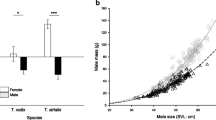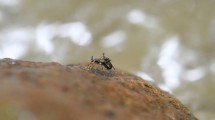Abstract
Females of many insect species analyse and select specific male signals for possible mates. Mate choice can benefit fecundity and survival of females, or have an indirect effect by providing optimal genes. Assortative mating by size is one of the most commonly observed sexual behaviors. Additionally, chemical cues may be detected by females, as these can also be indicators of body size and condition. Little is known about mate choice behavior among Thysanoptera. The mating system of Echinothrips americanus (Thysanoptera, Thripidae) is characterized by a strong competition for mates, leading to assortative mating. In this species very prominent gland structures are located on sternites III to VIII, of which the function still remains unknown. However, given the individual differences in expression of the gland release areas, a probable role in mate selection is postulated. In this study, we are interested in possible correlations between male body size, gland release areas, glandular substances, and mating success. Additionally, we used an experimental approach to test for a possible function in mate-assessment, or as an anti-aphrodisiac. Whereas pronotum length, distance between 1st and 2nd coxa, as well as total sternite area show a significant correlation with mating success, no direct correlation with sternal gland structures was observed. Furthermore, we failed to constitute a mate-assessment or anti-aphrodisiac-like function of sternal gland products.




Similar content being viewed by others
References
Akella SVS, Kirk WDJ, Lu YB, Murai T, Walters KFA, Hamilton JGC, Renou M (2014) Identification of the aggregation pheromone of the melon thrips, Thrips palmi. PLoS One 9:e103315. doi:10.1371/journal.pone.0103315
Resistance Database Archives (2017) IRAC- Insecticide Resistance Action Committee http://www.irac-online.org. Accessed 18 Jan 2017
Plant Health Australia (2010) Poinsettia thrips contingency plan http://www.planthealthaustralia.com.au/pests/poinsettia-thrips/. Accessed 16 Dec 2016
Baker RR (1983) Insect territoriality. Annu Rev Entomol 28:65–89
Banshiddhi K, Poonchaisri S (1991) Thrips in vegetables and other commercially important crops in Thailand. In: Talekar NS (ed) Thrips in South East Asia. AVRDC Publications, Bangkok, pp 34–39
Bernardo EN (1991) Thrips on vegetable crops in the Philippines. In: Talekar NS (ed) Thrips in South East Asia. AVRDC Publications, Bangkok, pp 5–11
Blows MW, Chenoweth SF, Hine E (2004) Orientation of the genetic variance-covariance matrix and the fitness surface for multiple male sexually selected traits. Amer Nat 163:329–340. doi:10.1086/381941
Bode W (1978) Ultrastructure of the sternal glands in Thrips validus Uzel (Thysanoptera, Terebrantia). Zoomorphologie 90:53–65. doi:10.1007/BF00993743
Bradbury JW, Vehrencamp SL (2011) Principals of animal communication, 2nd edn. Sinauer Associates, Sunderland
Clark DC, DeBano SJ, Moore AJ (1997) The influence of environmental quality on sexual selection in Nauphoeta cinerea (Dictyoptera: Blaberidae). Behav Ecol 8:46–53. doi:10.1093/beheco/8.1.46
Cloyd RA (2016) Western flower Thrips (Thysanoptera: Thripidae) and Insecticide resistance: an overview and strategies to mitigate Insecticide resistance development. J Entomol Sci 51:257–273. doi:10.18474/JES16-15.1
Conner WE, Roach B, Benedict E, Meinwald J, Eisner T (1990) Courtship pheromone production and body size as correlates of larval diet in males of the arctiid moth, Utetheisa-ornatrix. J Chem Ecol 16:543–552. doi:10.1007/BF01021785
Crespi BJ (1989) Causes of assortative mating in arthropods. Anim Behav 38:980–1000. doi:10.1016/S0003-3472(89)80138-1
Crespi BJ, Morris DC, Mound LA (2004) Evolution of ecological and behavioural diversity: Australians acacia Thrips as model organisms. Australian Biological Resources Study and Australian National Insect Collection, Canberra
De Kogel WJ, van Deventer P (2003) Intraspecific attraction in the western flower thrips Frankliniella occidentalis, indications for a male sex pheromone. Entomol Exp Appl 107:87–89. doi:10.1046/j.1570-7458.2003.00031.x
Fisher R (1915) The evolution of sexual preferences. Eugen Rev 7:184–192
Fisher R (1930) The Genetical theory of natural selection. Clarendon Press, Oxford
Gitaitis RD, Walcott RR, Wells ML, Diaz Perez JC, Sanders FH (2003) Transmissions of Pantoea ananatis, causal agent of center rot of onion, by tobacco thrips, Frankliniella fusca. Plant Dis 87:675–678
Hamilton JGC, Hall DR, Kirk WDJ (2005) Identification of a male-produced aggregation pheromone in the western flower thrips Frankliniella occidentalis. J Chem Ecol 31:1369–1379. doi:10.1007/s10886-005-1351-z
Heming B (1995) History of the germ line in male and female Thrips. In: Parker BL, Skinner M, Lewis T (eds) Thrips biology and management. Plenum Press, New York, pp 505–535
Hoddle MS, Mound LA, Paris DL (2008) Thrips of California. CD-ROM published by CBIT Publishing, Queensland http://www.lucidcentral.org/keys/v3/thrips_of_california/Thrips_of_California.html
Johansson BG, Jones TM (2007) The role of chemical communication in mate choice. Biol Rev 82:265–289. doi:10.1111/j.1469-185X.2007.00009.x
Jones DR (2005) Plant viruses transmitted by thrips. Eur J Plant Pathol 113:119–157. doi:10.1007/s10658-005-2334-1
Joosse S (2012) Fisher’s exact test http://in-silico.net/tools/statistics/fisher_exact_test. Accessed Oct 2015
Kirk WDJ, Hamilton JGC (2010) The aggregation pheromones in thrips. In: Persley D, Wilson C, Thomas J, Sharman M, Tree D (ed) IXth international symposium on Thysanoptera and Tospoviruses. J insect Sci 10, p 166
Klocke F (1926) Beiträge zur Anatomie und Histologie der Thysanopteren. Z wiss Zool, Abt A 128:1–36
Krueger S, Subramanian S, Niassy S, Moritz GB (2015) Sternal gland structures in males of bean flower thrips, Megalurothrips sjostedti, and poinsettia thrips, Echinothrips americanus, in comparison with those of western flower thrips, Frankliniella occidentalis (Thysanoptera: Thripidae). Arth Struct & Dev 44:455–467. doi:10.1016/j.asd.2015.07.002
Krueger S, Moritz G, Lindemann P, Radisch D, Tschuch G (2016a) Male pheromone influence the mating behavior of Echinothrips americanus. J Chem Ecol. doi:10.1007/s10886-016-0685-z
Krueger S, Mound LA, Moritz GB (2016b) Offspring sex ratio and development are determined by copulation activity in Echinothrips americanus MORGAN 1913 (Thysanoptera). J Appl Entomol 140:462–473. doi:10.1111/jen.12280
Krueger S, Jilge M, Mound LA, Moritz GB (2017) Reproductive behaviour of Echinothrips americanus (Thysanoptera: Thripidae). J Insect Sci 17(2):66
Kuijper B, Pen I, Weissing FJ (2012) A guide to sexual selection theory. Annu Rev Ecol Evol Syst 43:287–311. doi:10.1146/annurev-ecolsys-110411-160245
Kumm S (2002) Reproduction, progenesis and embryogenesis of thrips (Thysanoptera, Insecta). Dissertation. Martin-Luther-University Halle-Wittenberg, Germany
Lewis T (1997) Chemical control. In: Lewis T (ed) Thrips as crop pests. CAB International, Oxon, pp 567–593
Li X-W, Zhang X-C, Jiang H-X, Feng J-N (2012) Comparisons of developmental and reproductive biology between parthenogenetic and sexual Echinothrips americanus (Thysanoptera: Thripidae). Environ Entomol 41:706–713. doi:10.1603/EN11325
Li X-W, Jiang H-X, Zhang X-C, Shelton AM, Feng J-N (2014) Post-mating interactions and their effects on fitness of female and male Echinothrips americanus (Thysanoptera: Thripidae), a new insect pest in China. PLoS One 9:1–7. doi:10.1371/journal.pone.0087725
Moritz GB (2006) Thripse - Fransenflügler, Thysanoptera. Westarp-Verlag, Hohenwarsleben
Moritz GB (2011) Thysanoptera – Fransenflügler (Thripse). In: Klausnitzer B (ed) Stresemann Exkursionsfauna von Deutschland, Band 2, Wirbellose: Insekten. Springer Spektrum Akademischer Verlag, Heidelberg, pp 164–171
Moritz GB, Mound LA, Morris D, Goldarazena A (2004) Pest thrips of the world - an identification and information system using molecular and microscopial methods. Centre for Biological Information Technology, University of Queensland, Australia CD-ROM ISBN 1 86499 781 8. http://thripsnet.zoologie.uni-halle.de/key-server-neu/
Mound LA (1971) Gall-forming thrips and allied species (Thysanoptera: Phlaeothripinae) from acacia trees in Australia. Bull Br Mus Nat Hist 25:387–466. doi:10.5962/bhl.part.19680
Mound LA (1997) Biological Diversity. In: Lewis T (ed.) Thrips as crop pests. CAB International, Oxon, pp 197–215
Mound LA (2001) So many thrips-so few tospoviruses? In: Marullo R, Mound LA (eds) Thrips and Tospoviruses: proceedings of the 7th international symposium on Thysanoptera. Australian National Insect Collection, Canberra, pp 15–18
Mound LA (2009) Sternal pore plates (glandular areas) of male Thripidae (Thysanoptera). Zootaxa 2129:29–46. doi:10.5281/zenodo.188316
Oetting RD, Beshear RJ (1993) Biology of the greenhouse pest Echinothrips americanus Morgan (Thysanoptera: Thripidae). Int J Pure Appl Zool 4:307–315
Oetting RD, Beshear RJ, Liu TX, Braman SK, Baker JR (1993) Biology and identification of thrips on greenhouse ornamentals. Geo Agr Exp St Bull 414:20
Olaniran OA, Sudhakar AVS, Drijfhout FP, Dublon IAN, Hall DR, Hamilton JGC, Kirk WDJ (2013) A male-predominant cuticular hydrocarbon, 7-methyltricosane, is used as a contact pheromone in the western flower thrips Frankliniella occidentalis. J Chem Ecol 39:559–568. doi:10.1007/s10886-013-0272-5
Pelikan J (1951) On carnation thrips, Taeniothrips dianthi Priesner. Folia Entomol 14:5–38
Sastrosiswojo S (1991) Thrips in vegetables in Indonesia. In: Talekar NS (ed) Thrips in South East Asia. AVRDC Publications, Bangkok, pp 12–17
Shuker DM, Simmons LW (2014) The evolution of insect mating systems. Oxford University Press, Oxford
Stahr C, Svatos A, Seidelmann K (2013) Chemical identification, emission pattern and function of male-specific pheromones released by a rarely swarming locust, Schistocerca americana. J Chem Ecol 39:15–27. doi:10.1007/s10886-012-0233-4
Stannard LJ (1968) The Thrips, or Thysanoptera, of Illinois. Bull. Ill Nat Hist Surv 29:214–552
Terry IL, Dyreson E (1996) Behavior of Frankliniella occidentalis (Thysanoptera: Thripidae) within aggregations, and morphometric correlates of fighting. Ann Entomol Soc Am 89:589–602
Terry IL, Schneider M (1993) Copulatory behaviour and mating frequency of the western flower thrips, Frankliniella occidentalis (Insecta: Thysanoptera). IJPAZ 4:339–354
Thornhill R, Alcock J (1983) The evolution of insect mating systems. Harvard University Press, Cambridge
ThripsWiki (2017) ThripsWiki - providing information on the World's thrips http://thrips.info/w/index.php?title=Main. Accessed 17 Jan 2017
Trdan S, Milevoj L, Raspudic E, Zezlina I (2003) The first record of Echinothrips americanus Morgan in Slovenia. Acta Phytopathol Hun 38:157–166. doi:10.1556/APhyt.38.2003.1-2.18
Ullman D, Sherwood JL, German TL (1997) Thrips as vectors of plant pathogens. In: Lewis T (ed) Thrips as crop pests. CAB International, Oxon, pp 539–565
Vierbergen G (1998) Echinothrips americanus Morgan, a new thrips in Dutch greenhouses (Thysanoptera: Thripidae). Proc Exp Appl Entomol 9:155–160
Zhang P-J, Zhu X-Y, Lu Y-B (2011) Behavioural and chemical evidence of a male-produced aggregation pheromone in the flower thrips Frankliniella intonsa. Physiol Entomol 36:317–320. doi:10.1111/j.1365-3032.2011.00796.x
Zhu L, Shi B-C, Gong Y-J, Wang Z-H, Kang Z-J, Mirab-balou M (2013) Host preference of Echinothrips americanus Morgan for different vegetables. Acta Ecol Sin 33:1607–1614. doi:10.5846/stxb201210151433
zur Strassen R (2003) Die terebranten Thysanopteren Europas und des Mittelmeer-Gebietes. Die Tierwelt Deutschlands, Goecke & Evers, Keltern 74:1–271
Acknowledgements
We would like to thank candidate B.Sc. Christin Hesse for assistance and technical support.
Author information
Authors and Affiliations
Corresponding author
Electronic supplementary material
ESM 1
(DOCX 32.9 kb)
Rights and permissions
About this article
Cite this article
Krueger, S., Jilge, M., Mound, L. et al. Size Matters – Correlation of Body Size, Structure of Sternal Glands and Mating Success in Echinothrips Americanus (Thysanoptera: Thripidae). J Insect Behav 30, 409–419 (2017). https://doi.org/10.1007/s10905-017-9627-z
Revised:
Accepted:
Published:
Issue Date:
DOI: https://doi.org/10.1007/s10905-017-9627-z




